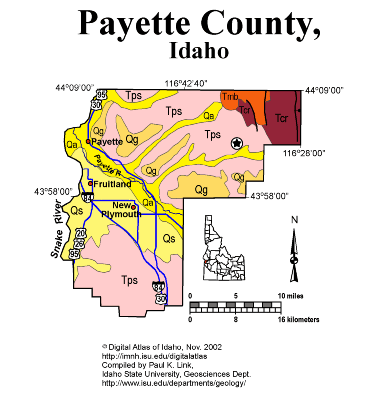
Geologic Units |
|
| Quaternary alluvial deposits | |
| Gravels and terraces on western Snake River Plain | |
| Quaternary surficial cover, fluveolian cover on Snake River Plain, alluvial fans (Snake River Group) | |
| Pliocene and Upper Miocene stream and lake deposits (Salt Lake Formation, Starlight Formation, Idaho Group) | |
| Miocene basalt (basalt of Weiser and basalt of Cuddy Mtn.) (split with Tpb is at 5 Ma) (includes rocks shown as Tpb (Bond, 1978) in Owyhee County and Mt. Bennett Hills | |
| Miocene basalt (Columbia River Basalt Group) |
| Map Key | |
| Geologic units with unit designation. | |
| Normal Fault: certain; dashed where approximately located; dotted where concealed. | |
| Thrust Fault: certain; dashed where approximately located; dotted where concealed. | |
| Detachment Fault: certain; dashed where approximately located; dotted where concealed. | |
| Interstate Route. | |
| U.S. Route. | |
| State Route. | |
| Location of Rockwalk rock from the county. | |
| Cities. | |
| Feature location. |
Payette County
Payette County contains the mouth of the Payette River where it empties into the Snake River, and forms the western border of Idaho. The bulk of the county is irrigated agricultural land, with agriculture occurring on Miocene lake beds and Quaternary stream deposits. A small area of Columbia River basalt is found in the northeast corner of the county, where it is cut by north-striking normal faults.
Cenozoic Geologic History of Gem and Payette Counties
The Cenozoic geologic history of Gem and Payette Counties is similar to many areas in southwestern Idaho. Volcanism resulted mainly from the faulting and initiation of the Western Snake River Plain in the Miocene. Miocene sedimentation occurred within the many lakes interconnected at times by a river system that was present in the newly formed rift environment. Columbia River volcanic flows and pyroclastic rocks that were erupted from both central and fissure-type vents represent the oldest volcanic rocks in the area. These lava flows temporarily blocked major surface water drainages causing extensive deposits of alluvial, fluvial and lacustrine sediments referred to as the Miocene - Pliocene Payette and Sucker Creek and Pliocene - Pleistocene Idaho Formations. The age of these sedimentary deposits ranges from Miocene to the Pleistocene. These units exhibit many sedimentary structures. The fluvial facies exhibits cross bedding, ripples, scouring, and delta foresets. Well-preserved fluvial and lacustrine facies of the Idaho Formation can be observed along Old Freeze Out Hill Road.
Columbia River basalts are widely distributed over Gem County and parts of eastern Payette County. Squaw Mountain represents a major block of the Columbia River Basalt which is estimated to have been uplifted approximately 2500' along its eastern margin (Savage, 1961). Other exposures of Columbia River basalts can be observed along the north side of Black Canyon Reservoir. Silicic volcanic rocks, rhyolitic welded ash flow tuffs, also crop out in the region and are stratigraphically above the Columbia River basalt units. Exposures of the rhyolitic ash flow tuff units can be observed in the Pearl region.
T. Schiappa and P.K. Link, 10/02
Additional Reading
Rocks Rails and Trails: page
Challis Volcanic Group & Intrusive Rocks
References on Idaho Geology
Click here to see a correlation of geologic units, and the associated time scale.
Click here for a printable version of this map.
Click here for a discussion of the geology of Payette and Gem Counties (PDF)
|
Click on the button below to search the IdahoGeologic
Survey's index of Geologic Maps
|
 |